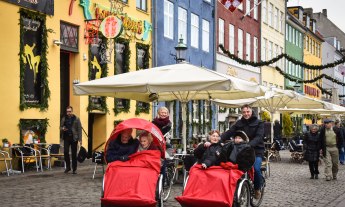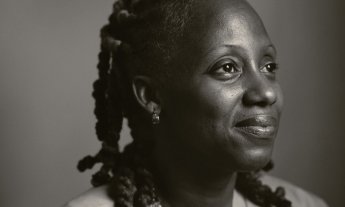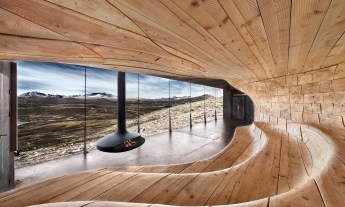
Imagine a place for the elderly that’s also filled with the sounds of kids playing. Marc Freedman goes to Singapore to investigate a new model for intergenerational living.
Sister Geraldine Tan, an energetic woman in her 60s, speaks rapidly and is given to sweeping gestures. She wears the flowing white robes of the Canossian Daughters of Charity, and they threaten to engulf her small frame. But Sister Geraldine — trained in the hospice movement in the UK and now the executive director of the St. Joseph’s Home for the Aged and Hospice in Singapore — is not easily overwhelmed.
St. Joseph’s is not your typical nursing home. It’s striking, with tropical flora, open pavilions and airy rooms, and large, accommodating some 400 older people. Natural light and trade winds flow through its floors.
But the people it serves aren’t all elderly. The facility includes a childcare center for about 50 children, ages two months to six years. At the center of St. Joseph’s courtyard is an intergenerational playground, home to spontaneous interactions between the older people at the nursing home and the little ones at the childcare center.
Singapore’s leaders see the generations growing apart. They’re eager to bring them back together, to find new ways to do old things.
The neighborhood isn’t typical, either. St. Joseph’s is in Jurong West, an industrial area gone high tech. Google Singapore is next door; on the other side is the Boys’ Home, which houses young people who have been in trouble with the authorities. Across the street is a primary school. The massive Supply Chain City building — a facility “that serves as Asia’s supply-chain nerve center” — is less than 100 yards away. St. Joseph’s sits in the middle, a bastion of humanity.
While many residents share a strong cultural respect for their elders, Singapore’s leaders see the generations growing apart. They’re eager to bring them back together, to find new ways to do old things. This fits Sister Geraldine’s vision. She is determined to create an environment that encompasses the full “circle of life,” as she puts it, with children at its center. “They remind us of the purpose of life and of the importance of play and simplicity,” she says.
“There is birth and there is death,” says Sister Geraldine. “At both ends, we all need someone to tend to us.”
Today, one in eight people in Singapore is aged 65 and older. By 2030, it will be one in four.
Just as the childcare center aims to foster bonds that benefit young and old, students at the primary school visit regularly, and some of them are being mentored by the seniors. Boys’ Home residents operate a coffee cart in the courtyard, delivering drinks to the older people at St. Joseph’s — another way Sister Geraldine is instigating meaningful, cross-generational relationships.
Sister Geraldine and St. Joseph’s are all part of Singapore’s scheme to deal with their aging population. The wealthy city-state has put forth a national plan to invest $3 billion Singapore ($2.1 billion in USD) and become the envy of other aging societies. It’s a staggering investment given Singapore’s population size: just under four million permanent residents, about the size of Chicago.
Like many countries in Asia and the rest of the world, Singapore is aging fast. In 1970, one in 31 Singaporeans was 65 or older; today, it’s one in eight. By 2030, it will be one in four, or from about 440,000 people over 65 to more than 900,000 by 2030. “Aging is really the single most important demographic shift that will affect the future of Singapore,” says Amy Khor, the government’s senior minister of state for health.
Singapore officials are promoting “3Gen flats” to help older people, younger people, and those in the middle live in close proximity.
As in much of the world, the change is caused by increasing longevity and decreasing birth rates. In February 2016, Khor announced the Action Plan for Successful Ageing, an ambitious collection of some 70 initiatives covering a wide array of issues, including health care, volunteerism, employment, housing, transportation and protection for vulnerable elders. A leitmotif is engaging older people to support the next generation behind them.
To bring the generations together, Singapore is launching programs to help older people retool for second acts, to recruit young people to teach technology and social media skills to older folks, and to help community organizations better use senior volunteers. Officials are promoting “3Gen flats” to help older people, younger people, and those in the middle live in close proximity. One of the Plan’s most striking features is the creation of a “Kampong for All Ages.” Kampong is the Malay word for village, and it envisions a future Singapore built around a cherished element of the past: the multigenerational village.
The Plan also funds a $200 million Singapore ($140 million in USD) National Innovation Challenge, toward research on promising models and incentives to encourage more ideas for a multigenerational society.
The idea is to use community design to re-create natural opportunities for cross-generational support — to move from program to proximity, from concept to reality.
I sat down with two young architects at the CDB, the ministry that oversees land use in Singapore, where space is at an absolute premium. They showed me plans for the Admiralty Kampong, a development created to encourage connection between the generations. It will contain a ground-floor plaza with a grocery store and eateries, a daycare center, assisted-living services, a day center for elders with more extensive needs, and lots of opportunities for socializing.
The idea is to use community design to re-create natural opportunities for cross-generational support — to move from program to proximity, from concept to reality. The conscious effort is all the more striking in an Asian society where interaction and care between young and old, especially in families, occurred naturally for much of its history. But in our fast-paced, highly mobile, globally-oriented 21st-century world, there’s a need to find new ways to cultivate these time-honored values.
I admit being taken with Singapore’s plan, but my burning question on arrival and throughout my visit was: Is it real or a mirage? Some experiences were underwhelming. At one point, I visited the nation’s oldest center that brings together children, adolescents and older adults. The program’s diversity was impressive, mixing many different ethnic backgrounds, as well as ages. Yet the contact between generations was mostly superficial — there was a patina of closeness without much in the way of genuine interaction.
Scarcity of space could have led to conflict; instead, it’s prompting creative thinking about how to wring the most social value from limited square footage.
Still, those experiences were the exception for me. In Singapore, for the most part, I witnessed a sense of common purpose among people to realize the plan’s goals, a shared vision that was more significant in some ways than the sums being spent (although I can’t get over my envy of the money).
Two lessons stood out for me from my trip. First, not having much land can be a powerful impetus for change. Scarcity of space could have led to conflict; instead, it’s prompting creative thinking about how to combine institutional purposes to wring the most social value from limited square footage. Second, I found the instinct to combine old and new — a new-way-to-do-old-things approach — everywhere.
On my final day, I visited a church initiative that was a faith-based bookend to the St. Joseph’s experience that started my trip. St. John’s–St. Margaret’s is a well-established Anglican congregation near the National University of Singapore. The church is in the midst of creating a large senior living facility and early childhood center, having broken ground on it in mid-2017.
When complete, the project may be even more impressive than St. Joseph’s. This redesign was prompted by the expiration of the church’s lease on government-owned land. In order to stay on its prized plot, St. John’s–St. Margaret’s was required to “intensify” its use of the land — to do more social good. The congregation decided not only to build a nursing home and senior programs but also to find ways to simultaneously support young children. I love the notion of intensifying the land; it’s another way of saying every dollar should be spent (at least) twice.
When complete, St. John’s-St. Margaret’s will contain a nursing home, a senior center, and an early childhood center. Its name? Project Spring-Winter.
For insights, the St. John’s–St. Margaret’s team headed to the US and visited facilities that bring the generations together for mutual benefit, including the Providence Mount St. Vincent Intergenerational Learning Center in Seattle (the subject of the 2017 documentary The Growing Season). Another source of inspiration was a passage from Zechariah 8:4–5 that describes the renewed city of Jerusalem as a cross-generational paradise: “Old men and old women shall again sit in the streets of Jerusalem, each with staff in hand because of great age. And … the city shall be full of boys and girls playing in its streets.”
When open in 2021, St. John’s–St. Margaret’s will consist of a 273-person nursing-home facility, a senior center for 100 older people, and an early childhood center for 200 children. The name for the initiative? Project Spring-Winter.
When I visited the congregation members leading this effort, they told me of an unanticipated side benefit. While working on the plans, they realized the church itself had become age-segregated — for example, there were children’s services and adult services, often held at the same time in separate rooms. Prompted by the research that’s gone into Project Spring-Winter, they’re thinking how best to age-integrate the congregation.
Congregant Sherlyn Lee, one of the Project Spring-Winter leaders, told me that she hopes this new effort will restore a sense of the “circle of life” — both at the church and in Singapore. I was struck by the symmetry: Sister Geraldine and Sherlyn opened and closed my trip with the same beautiful phrase.
Excerpted from the new book How to Live Forever: The Enduring Power of Connecting the Generations by Marc Freedman. Published by PublicAffairs, an imprint of Hachette Book Group. Copyright © 2018 Marc Freedman.
Watch his TEDxSanFranciscoSalon talk here:














